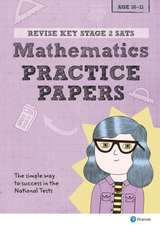Standard Setting: A Guide to Establishing and Evaluating Performance Standards on Tests
Autor Gregory J. Cizek, Michael B. Bunchen Limba Engleză Paperback – 17 ian 2007
"Offers an overview of the importance of standard setting, current demands, legislation, formats, and licensure and certification contents
"Provides a detailed look at the distinctions between oft-confused concepts such as "content standards" and "performance standards"
"Gives a straightforward review of the common elements in setting performance standards
"Provides detailed inclusion of the various methods (Angoff, Item Mapping, Analystic Judgment, etc.)for setting performance standards
"Includes a full chapter devoted to the future issues and research in standard setting as well as a glossary of key terms and a full set of references to aid the reader's literature review
| Toate formatele și edițiile | Preț | Express |
|---|---|---|
| Paperback (1) | 723.83 lei 43-57 zile | |
| SAGE Publications – 17 ian 2007 | 723.83 lei 43-57 zile | |
| Hardback (1) | 998.97 lei 43-57 zile | |
| SAGE Publications – 5 feb 2007 | 998.97 lei 43-57 zile |
Preț: 723.83 lei
Preț vechi: 882.71 lei
-18% Nou
Puncte Express: 1086
Preț estimativ în valută:
138.50€ • 144.100$ • 114.60£
138.50€ • 144.100$ • 114.60£
Carte tipărită la comandă
Livrare economică 07-21 aprilie
Preluare comenzi: 021 569.72.76
Specificații
ISBN-13: 9781412916837
ISBN-10: 1412916836
Pagini: 368
Ilustrații: Illustrations
Dimensiuni: 152 x 229 x 20 mm
Greutate: 0.49 kg
Ediția:First Edition
Editura: SAGE Publications
Colecția Sage Publications, Inc
Locul publicării:Thousand Oaks, United States
ISBN-10: 1412916836
Pagini: 368
Ilustrații: Illustrations
Dimensiuni: 152 x 229 x 20 mm
Greutate: 0.49 kg
Ediția:First Edition
Editura: SAGE Publications
Colecția Sage Publications, Inc
Locul publicării:Thousand Oaks, United States
Recenzii
A well-timed text, given the legislated requirement of performance standards in our K-12 educational system, as well as the continued need in the process of credentialing professionals. This book would be useful to individuals retained to produce or coordinate standard-setting activites.
It is abundantly apparent that the authors know standard setting and themselves have implemented numerous standard-setting procedures using different methods for different types of assessment programs.... Although the book is very practical, someone who has a fair amount of knowledge in standard setting will not feel shortchanged. There is a richness in the discussions of the methods that engages the reader, such as the different modifications of a method and the situational challenge that warranted each modification. Also, when a specific implementation of a method is discussed in detail, the authors are very conscientious in discussing the impetus for the adaptations. The historical perspective presented for some of the methods is quite intriguing.
It is abundantly apparent that the authors know standard setting and themselves have implemented numerous standard-setting procedures using different methods for different types of assessment programs.... Although the book is very practical, someone who has a fair amount of knowledge in standard setting will not feel shortchanged. There is a richness in the discussions of the methods that engages the reader, such as the different modifications of a method and the situational challenge that warranted each modification. Also, when a specific implementation of a method is discussed in detail, the authors are very conscientious in discussing the impetus for the adaptations. The historical perspective presented for some of the methods is quite intriguing.
Cuprins
SECTION I: FUNDAMENTALS OF STANDARD SETTING
1. Contemporary Standard Setting: An Enduring Need
The Need to Make Decisions
The Benefits of Standard Setting
General Approaches to Standard Setting
Current Contexts for Standard Setting
2. What is Standard Setting?
Kinds of Standards
Definitions of Standard Setting
Policy Issues and Standard Setting
Item Scoring Criteria and Total-Test Performance Standards
Conclusions
3. Common Elements in Setting Preformance Standards
Purpose
Choosing a Standard Setting Method
Performance Level Labels
Performance Level Descriptions
Key Conceptualizations
Selecting and Training Participants
Evaluating Standard Setting
Providing Feedback to Participants
Professional Guidelines for Standard Setting
Evaluating Standard Setting
Conclusions
SECTION II: STANDARD SETTING METHODS
4. The Nedelsky Method
Procedures for the Nedelsky Method
Alternative Procedures and Limitations
5. The Ebel Method
Procedures for the Ebel Method
Alternative Procedures and Limitations
6. The Angoff Method and Angoff Variations
Procedures for the Angoff Method
Procedures for Angoff Variations
Alternative Procedures and Limitations
7. The Direct Consensus Method
Procedures for the Direct Consensus Method
Alternative Procedures and Limitations
8. The Contrasting Groups and Borderline Group Methods
Procedures for the Contrasting Groups Method
An Example Using the Contrasting Groups Method
The Borderline Group Method
Alternative Procedures and Limitations
9. The Body of Work and Other Holistic Methods
The Judgmental Policy Capturing Method
The Dominant Profile Method
The Analytic Judgment Method
Summary Analysis of Three Holistic Methods
Overview of the Body of Work Method
Procedures for the Body of Work Method
An Application the Body of Work Method
Alternative Procedures and Limitations
10. The Bookmark Method
Overview of the Bookmark Method
An Implementation of the Bookmark Method
Alternative Procedures and Limitations
11. The Item-Descriptor Matching Method
Procedures for the IDM Method
Alternative Procedures and Limitations
12. The Hofstee and Beuk Methods
The Hofstee Method
Procedures for Implementing the Hofstee Method
The Beuk Method
Procedures for Implementing the Beuk Method
Alternative Procedures and Limitations
SECTION III: CHALLENGES AND FUTURE DIRECTIONS IN STANDARD SETTING
13. Scheduling Standard Setting Activities
Scheduling Standard Setting for Educational Assessments
Scheduling Standard Setting for Credentialing Programs
Conclusions and Recommendations
14. Vertically-Moderated Standard Setting
The Interrelated Challenges
A Brief History of Vertically-Moderated Standard Setting
What Is Vertically-Moderated Standard Setting?
Approaches to VMSS
Applications of VMSS
An Illustration of VMSS Procedures
Alternative Procedures and Limitations
15. Standard Setting on Alternate Assessments
The Unique Challenges of Alternate Assessment
Necessary Conditions for Alternate Assessment Systems
A Generalized Holistic (GH) Method
Limitations and Alternative Procedures
16. Special Topics and Next Steps
Rounding
Methods of Adjusting Cut Scores
Deciding How to Incorporate Uncertainty
Generalizability of Standards
Using Multiple Methods of Standard Setting
Improving Participant Training
1. Contemporary Standard Setting: An Enduring Need
The Need to Make Decisions
The Benefits of Standard Setting
General Approaches to Standard Setting
Current Contexts for Standard Setting
2. What is Standard Setting?
Kinds of Standards
Definitions of Standard Setting
Policy Issues and Standard Setting
Item Scoring Criteria and Total-Test Performance Standards
Conclusions
3. Common Elements in Setting Preformance Standards
Purpose
Choosing a Standard Setting Method
Performance Level Labels
Performance Level Descriptions
Key Conceptualizations
Selecting and Training Participants
Evaluating Standard Setting
Providing Feedback to Participants
Professional Guidelines for Standard Setting
Evaluating Standard Setting
Conclusions
SECTION II: STANDARD SETTING METHODS
4. The Nedelsky Method
Procedures for the Nedelsky Method
Alternative Procedures and Limitations
5. The Ebel Method
Procedures for the Ebel Method
Alternative Procedures and Limitations
6. The Angoff Method and Angoff Variations
Procedures for the Angoff Method
Procedures for Angoff Variations
Alternative Procedures and Limitations
7. The Direct Consensus Method
Procedures for the Direct Consensus Method
Alternative Procedures and Limitations
8. The Contrasting Groups and Borderline Group Methods
Procedures for the Contrasting Groups Method
An Example Using the Contrasting Groups Method
The Borderline Group Method
Alternative Procedures and Limitations
9. The Body of Work and Other Holistic Methods
The Judgmental Policy Capturing Method
The Dominant Profile Method
The Analytic Judgment Method
Summary Analysis of Three Holistic Methods
Overview of the Body of Work Method
Procedures for the Body of Work Method
An Application the Body of Work Method
Alternative Procedures and Limitations
10. The Bookmark Method
Overview of the Bookmark Method
An Implementation of the Bookmark Method
Alternative Procedures and Limitations
11. The Item-Descriptor Matching Method
Procedures for the IDM Method
Alternative Procedures and Limitations
12. The Hofstee and Beuk Methods
The Hofstee Method
Procedures for Implementing the Hofstee Method
The Beuk Method
Procedures for Implementing the Beuk Method
Alternative Procedures and Limitations
SECTION III: CHALLENGES AND FUTURE DIRECTIONS IN STANDARD SETTING
13. Scheduling Standard Setting Activities
Scheduling Standard Setting for Educational Assessments
Scheduling Standard Setting for Credentialing Programs
Conclusions and Recommendations
14. Vertically-Moderated Standard Setting
The Interrelated Challenges
A Brief History of Vertically-Moderated Standard Setting
What Is Vertically-Moderated Standard Setting?
Approaches to VMSS
Applications of VMSS
An Illustration of VMSS Procedures
Alternative Procedures and Limitations
15. Standard Setting on Alternate Assessments
The Unique Challenges of Alternate Assessment
Necessary Conditions for Alternate Assessment Systems
A Generalized Holistic (GH) Method
Limitations and Alternative Procedures
16. Special Topics and Next Steps
Rounding
Methods of Adjusting Cut Scores
Deciding How to Incorporate Uncertainty
Generalizability of Standards
Using Multiple Methods of Standard Setting
Improving Participant Training
Notă biografică
Descriere
In Standard Setting: A Guide to Establishing and Evaluating Performance Standards on Tests, authors Gregory J. Cizek and Michael B. Bunch provide the only "go-to" reference on how to set standards on tests in education, licensure, and certification. This book is comprehensive in scope, practical in nature, and definitive in terms of cataloguing the essential conceptual and procedural fundamentals of setting performance standards.








